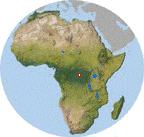Primary source for the following Site Data is McGrew et. al. (1996), Great Ape Societies (Cambridge University Press), Appendix.
|
Name: |
Station de Wamba, Centre de Recherche en Ecologie et Forestiere |
|
Location: |
Congo [ex-Zaire], Province Collectivite de Luo, Zone de Djolu, Sous-region de Tshuapa, 00° 11' N 22° 28' E |
|
Status: |
Scientific Reserve |
|
Area: |
350km2 |
|
Altitude: |
370-430m |
|
Temp: | DEGREES°C |
|
Rainfall: |
2000mm
|
|
Vegetation: |
Rainforest-derived mosaic of dry, swamp, and secondary forest, cultivated fields. A species list is available at http://www.primate.wisc.edu/pin/tro1.html |
Human
influence: |
Selective logging, hunting, provisioning
Disturbance ratings -- 4, 4, 2, 3, 3 |
Closest
village: |
Adjacent |
Species
studied: |
P. paniscus |
Population
density: |
--- individuals per km2 |
|
Fauna: |
Perodicticus potto, Galago demidovii, Colobus angolensis, C. badius, Cercopithecus ascanius, C. wolfi, C. neglectus, C. salongo, Allenopithecus nigroviridis, Cercocebus aterrimus, Panthera pardus |
Study
period: |
1974-1981, 1983-1991, 1994 |
|
Habituation: |
Good for 3 groups, fair for 2 groups, poor for 1 group |
Research
presence: |
Seasonal, occasional |
|
Conservation: |
Guards' training |
Current
research: |
Sexual development, intergroup relationships, adoption |
|
Methods: |
Focal-subject sampling, ad libitum sampling, video recording |
Contact
person: |
Takayoshi Kano, Kyoto University Primate Research Institute, Inuyama, Japan 484 |
|
Habitat photos
|
---
|
|
Maps
|
---
|
|
Aerial photos
|
---
|
|
Bibliography
| Assorted references relating to Wamba |
|
- Furuichi, T. (1989). Social interactions and the life history of female Pan paniscus in Wamba. Int. J. Primatol. 10: 173-197.
- Furuichi, T. (1997). Agonistic interactions and matrifocal dominance rank of wild bonobos (Pan paniscus) at Wamba. Int. J. Primatol. 18: 855-875.
- Hashimoto, C. (1997). Context and development of sexual behavior of wild bonobos (Pan paniscus) at Wamba, Zaire. Int. J. Primatol. 18: 1-21.
- Hashimoto, C., Furuichi, T. & Takenaka, O. (1996). Matrilineal kin relationship and social behavior of wild bonobos (Pan paniscus) -- sequencing the D-loop region of mitochondrial DNA. Primates. 37: 305-318.
- Idani, G. (1991). Social relationships between immigrant and resident bonobo (Pan paniscus) females at Wamba. Folia primatol. 57: 83-95.
- Idani, G. (1995). Function of peering behavior among bonobos (Pan paniscus) at Wamba, Zaire. Primates. 36: 377-383.
- Idani, G., Kuroda, S., Kano, T. & Asato, R. (1994). Flora and vegetation of Wamba Forest, Central Zaire with reference to bonobo (Pan paniscus) foods. Tropics. 3: 309-332.
- Ihobe, H. (1990). Interspecific interactions between wild pygmy chimpanzees (Pan paniscus) and red colobus (Colobus badius). Primates. 31: 109-112.
- Ihobe, H. (1992). Male-male relationships among wild bonobos (Pan paniscus) at Wamba, Republic of Zaire. Primates. 33: 163-179.
- Ihobe, H. (1992). Observations on the meat-eating behavior of wild bonobos (Pan paniscus) at Wamba, Republic of Zaire. Primates. 33: 247-250.
- Kano, T. (1992). The Last Ape: Pygmy Chimpanzee Behavior and Ecology. Stanford CA: Stanford University Press.
- Kano, T. & Mulavwa, M. (1984). Feeding ecology of the pygmy chimpanzees (Pan paniscus) of Wamba. pp. 233-274 IN Susman, R. L. (Ed.), The Pygmy Chimpanzee. New York: Plenum.
- Kuroda, S. (1980). Social behavior of the pygmy chimpanzees. Primates. 21: 181-197.
|
|
Miscellaneous
|
Related links
|
 Wamba, D. R. Congo
Wamba, D. R. Congo Wamba, D. R. Congo
Wamba, D. R. Congo